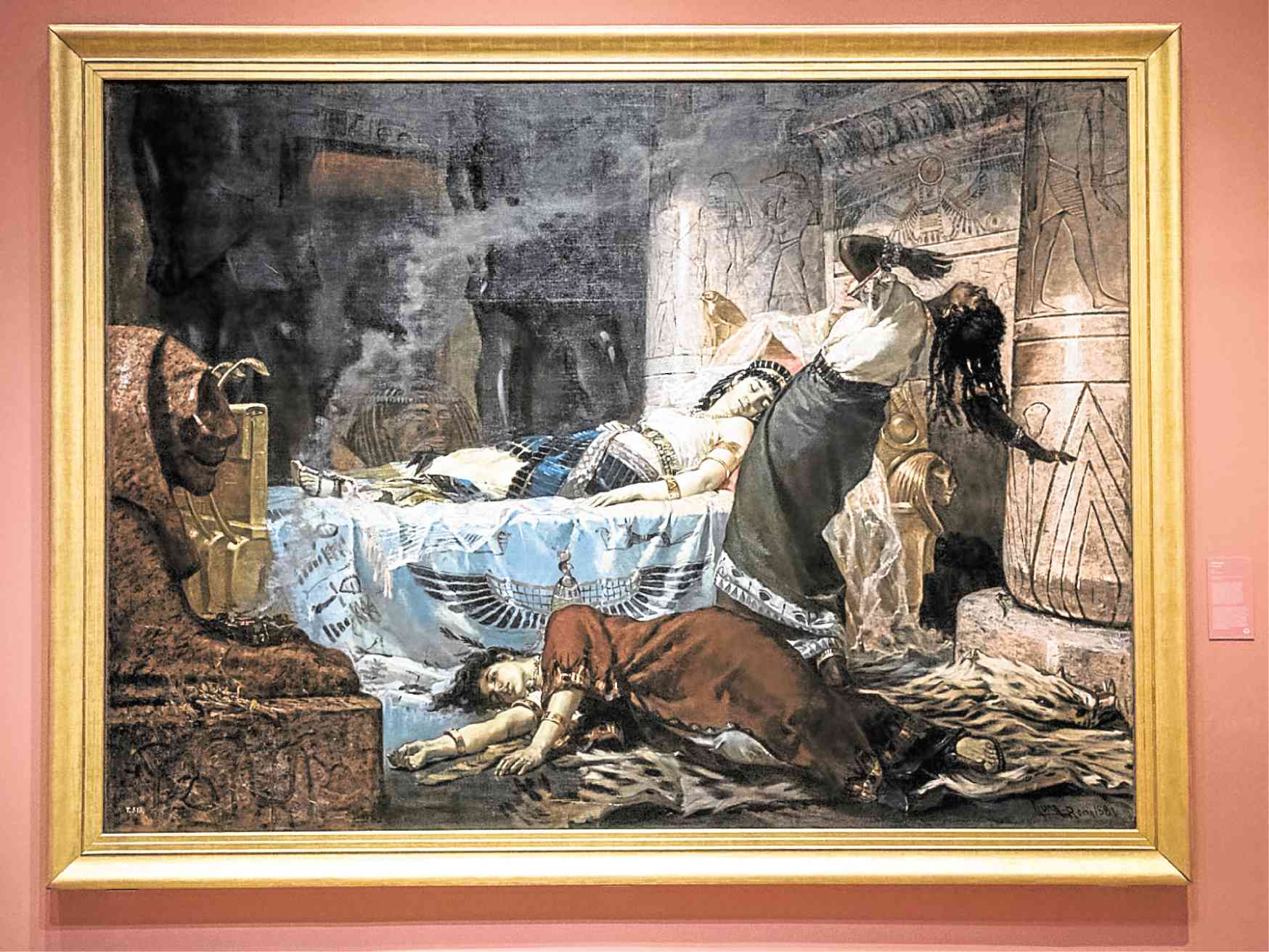
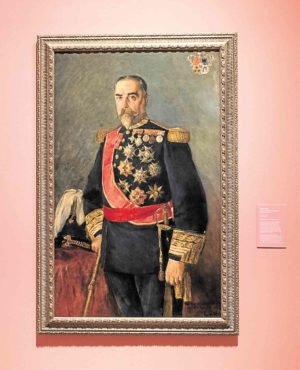
The National Gallery Singapore (NGS) is mounting up to March 11 the largest exhibit in 30 years of Philippine artist Juan Novicio Luna. The exhibit is very significant because it affords Filipinos the chance to finally see for themselves Luna’s most celebrated work after “Spoliarium”—“La Muerte de Cleopatra” (The Death of Cleopatra).
“Cleopatra” prefigured Luna’s triumph in the 1884 Madrid Exposition of Fine Arts where “Spoliarium” won the first-class medal, catapulting him to European renown. “Cleopatra” had much earlier won the second-class medal during the 1881 edition of the same expo.
But while “Spoliarium” was repatriated to the Philippines in 1958 and now holds foremost pride of place at the National Museum in Manila, “Cleopatra” stayed at Spain’s Museo Nacional del Prado, where it was not exhibited.
Now, Prado has restored and loaned “Cleopatra” to the NGS for the latter’s important exhibit, “Century of Light,” which is focused on 19th-century art.
Two components
The exhibit has two components: “Colours of Impressionism,” consisting of works by Edouard Manet, Auguste Renoir, Claude Monet and other noted French impressionists from the collection of the Musée d’Orsay; and “Between Two Worlds,” an exhibit at the NGS’ Singtel Special Exhibitions Gallery, of the life and work of Luna and another 19th-century Southeast Asian artist, Raden Saleh of Indonesia.
“Saleh and Luna are two of the earliest and most significant artists who propelled the prestige of Southeast Asian art around the world in the 19th century,” said Eugene Tan, director of the National Gallery Singapore (NGS).
Although Luna shares the Singtel gallery with Saleh, his exhibit is quite extensive and features heretofore unseen works from collections not familiar to Philippine art lovers. Luna and Saleh are allotted three huge halls each, enough to give justice to their respective life and oeuvre.
The last time a Luna exhibit the size of the Singapore showcase was mounted was in 1988 at the National Museum of the Philippines (NMP) and Metropolitan Museum of Manila. It tackled his life and work along with those of his contemporary and rival, Felix Resurreccion Hidalgo.
That was 30 years ago, and the new generation of Filipinos should be introduced to Luna. The Singapore exhibit provides that introduction.
Earliest works
Entering Singtel’s Luna hall, one is greeted by his portrait done by Gaston Blocquel O’Farrell, his French-Filipino student. The undated oil-on-canvas is from the collection of the Lopez Museum and Library; it is a copy of Luna’s “auto-retrato” or self-portrait.
The first hall contains Luna’s earliest works, the most signifcant of which are on loan to NGS by Lopez Museum: “Virgen Inmaculada” (1875) and “El Violinista” (1876).
The former is obviously a genre work, a religious painting of the Immaculate Conception, the titular saint of the Cathedral of Manila. The belief that Mary the mother of Jesus had been immaculately conceived had been defined as a dogma by Pope Pius IX in 1854, three years before Luna was born.

The latter is probably a portrait of his brother Manuel Luna, who became a violinist, when he was a boy. They were done by Luna when he was tutored by Philippine painter Lorenzo Guerrero and when he briefly enrolled with the Academia de Dibujo y Pintura. Juan and Manuel Luna were discouraged by their parents from taking up the arts, but to no avail. In 1877, the Luna brothers went to Spain—Manuel to study music, Juan to to study painting.
In Madrid, Luna attended the Real Academia de Bellas Artes de San Fernando, which is now a museum and art gallery. Goya was at one time a director of San Fernando, whose alumni include Picasso, Dali, Botero and, surprise, Oscar de la Renta. Among the works of Luna’s academic training were copies of Diego Velazquez’s “Aesop” and “Mennipus,” which are on exhibit at NGS.
Neoclassic paintings
Luna became an apprentice of the Spanish painter Alejo Vera (1834-1933), whom he called his “teacher and father.” The vogue at that time both in Madrid and the salons of Paris were neoclassic paintings—
that is, art whose subjects hail from the classical era of the ancient Greeks and Romans. Painting students were trained to tackle neoclassic themes.
At NGS, one could compare Vera’s “Vestal” virgin (1876), on loan from the Prado, with Luna’s version of the same subject, “Sacerdotista” (Priestess; 1883), from the Casa-Museo Benlliure, Ayuntamiento de Valencia, Spain.
In 1878, Luna accompanied Vera to Rome. It was in Rome where he painted “Cleopatra,” but he also seemed to have made departures from neoclassicism as shown by such works as “Italian Soldier” (1881), on loan to NGS from the University of Santo Tomas Museum, and “The Flautist” (1881) from the Lopez Museum. He also painted the portrait of Pedro Paterno (1882), on loan from the Bangko Sentral ng Pilipinas.
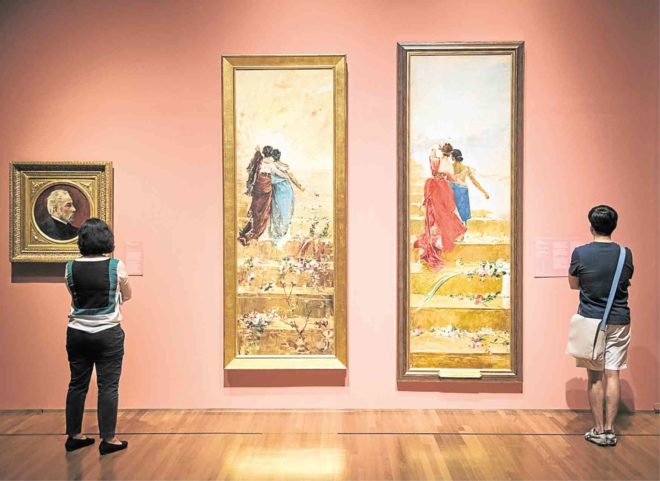
After the triumph of “Spoliarium” in 1884, Luna became the toast of the European art world and received several commissions. One of his most important commissions was from the Spanish government itself, “The Battle of Lepanto” (1887), which now hangs in the Spanish Senate. A study of the huge work can be seen in the NGS; it is on loan from the NMP.
Another major work
But it appears that on the same year “Spoliarium”—a major work that took him months to make—was first exhibited, Luna also created another major work, “España y Filipinas,” his famous allegory of Spain leading the Philippines to progress. Filipinos are most familiar, of course, with the undated painting from the Lopez Museum, which scholars guess could have been made in 1888.
But in 2012, an earlier painting dated 1884 was acquired by NGS; both paintings are on exhibit in Singapore. It appears now that Luna made six versions of the work, the largest of which is in the Prado.
In late 1884, Luna went to Paris and established a studio there. On view at NGS are such works as “Odalisque” and its watercolor study (both 1886), from the Luis Ma. Araneta Collection; and “Nude” (1884) from the Biblioteca Museu Victor Balaguer, from Villanova I la Geltru, Spain. Balaguer was the Spanish “Ultramar” or overseas minister who became friends with Luna, and the Singapore exhibit shows several works from his collection that has become a museum foundation.
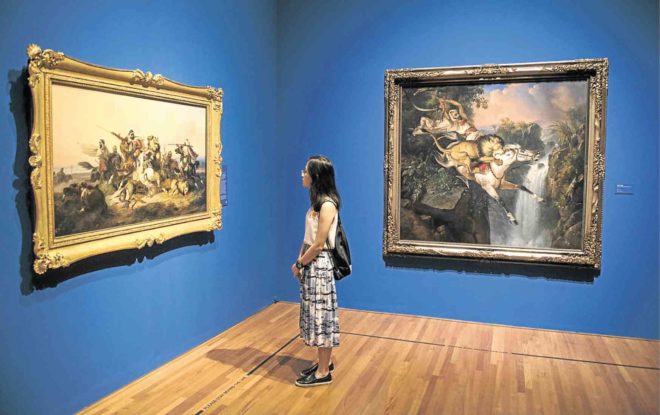
Other familiar Luna works on exhibit from this period are “Woman with a Manton” (1889), from the Ayala Museum, and “Normandy Scenes,” from the Bank of the Philippine Islands (BPI) Collection and the UP Vargas Museum.
Particularly interesting is an oil-on-wood self-portrait Luna did in 1886 in fencing mode (when he went back to the Philippines, he established a fencing school in Sampaloc), from the collection of Paulino and Hetty Que.
But perhaps the most surprising and charming of the paintings he did during this period was “La Mestiza” (also known as “Charing,” 1887), an oil-on-canvas from the Balaguer museum depicting the subject dressed in baro’t saya.
Path of Realism
Luna was in Paris at the height of French Impressionism, and while some Philippine art scholars have conjectured he might have have been influenced by the movement, the fact is that he abhorred it. After attending an exhibit by the Society of Independent Artists such as Henri Rousseau, Georges Seurat and Vincent Van Gogh, Luna told Rizal that “some of the artists are crazy, others are incompetent.”
Instead of Impressionism, Luna took the path of Realism. After “Cleopatra,” perhaps the best reason to see the Singapore show is that it affords Filipinos their first and best view of Luna’s realist works, especially the very large canvas, “Las Ignores” (The Unknown Ones; 1890-1891), which depicts a funeral cortège, and “Avant-garde” (The Advance Guard; 1892), which depicts poor old working women sweeping the streets, so that Luna might have meant the title to be both ironic and revolutionary.
The realist paintings, on loan from the Balaguer museum, were done around the time Luna was in Paris and having domestic troubles, which ended tragically when he killed his wife and mother-in-law in a fit of jealousy.
In a celebrated trial, he was acquitted by a Paris court in 1893. The case was a press sensation, and NGS shows Paris newspapers with blaring headlines of the trial.
Luna’s popularity
Also exhibited are Spanish and European newspapers and magazines with Luna on the cover, or with lithographs and reproductions of his celebrated works.
One of the covers (Madrid Comico) showed Luna dressed in a Japanese kimono, betraying the European art-world vogue of Japonisme in the late 19th century. Obviously the press was hard-pressed to ride the bandwagon of Luna’s popularity, but was ignorant of the Philippines and its native costumes.
The generous press clippings include La Ilustracion Española y Americana, where Luna’s triumphs were reported and lithographs of his celebrated works were reproduced. They also include the Manila paper El Comercio, which published a lithograph of “Spoliarium,” most probably the first time that Filipinos got a glimpse of what was to become the most important work of art by a Filipino.
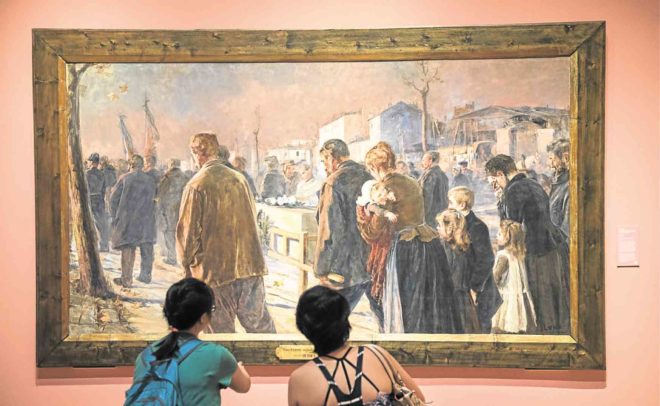
Museumgoers should also check out the late 19th-century photographs of Luna with Rizal and other Philippine expatriates in Europe, and with his European friends, such as the Italian Benliure brothers.
Mariano Benliure made in 1884 a bronze-painted plaster bust of the young Luna at the height of his European acclaim. The bust is on show at NGS, on loan from the UST Museum.
Grim splendor
La Ilustracion and El Comercio clippings should show that Filipinos have never really actually seen “La Muerte de Cleopatra” except through lithographs or photographs. Now, Filipinos can view the work in Singapore in all its grim splendor.
Following the Greek historian Plutarch’s “Lives,” Luna depicted the Egyptian queen’s suicide at the moment of its discovery: dressed in royal regalia, Cleopatra has just expired, along with a lady in waiting who has collapsed on the floor and another on the verge of falling down.
Barely seen at the foot of a pillar is the tail of a snake slithering away, which goes along with the popular lore that the beautiful royal had herself killed by the bite of an asp.
The work is significant because, as NGS curator Clarissa Chikiamco said, “‘Cleopatra’ gave Juan Luna his first major recognition in Europe and, at that point, was the highest artistic achievement received by any Filipino.”
“Even before ‘Spoliarium,’” Chikiamco explained, “Luna started appearing in Spanish publications for ‘Cleopatra’ while being acknowledged as a Filipino artist. We should remember that the term Filipino initially meant the Spaniards born in the Philippines, and natives were merely referred to as indio. Luna’s acknowledgement as a Filipino reflects that the idea of Filipino was changing amidst rising nationalism. Moreover, Luna received the recognition in the major art competition of the Philippines’ colonizer.”
“This accomplishment is overshadowed by ‘Spoliarium’ because that work won the first-class medal, and Félix Resurrección Hidalgo won the second-class medal for ‘Jóvenes Cristianas Expuestas al Populacho,’ in the same competition three years later. This double achievement of 1884 is certainly something to be celebrated, but ‘Cleopatra’ is a forerunner to that.”
Even ahead of “Spoliarium,” “Cleopatra’s” victory when Luna was only 24 years old signaled not only his rise as an artist from Spain’s only Asian colony, but also contributed to the formation of the national imaginary of the Philippines. José Rizal may nowadays be called “The First Filipino,” but it was Luna who was ahead of him in providing the visual imaginary of Philippine genius. That’s why Nick Joaquin called Luna “The Archetypal Filipino.”

